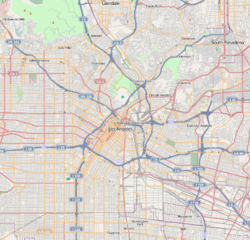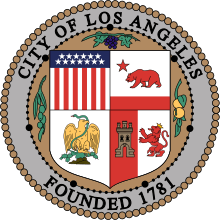Lafayette Square, Los Angeles
LaFayette Square is a historic semi-gated neighborhood in the central region of Los Angeles, California.[1]
LaFayette Square | |
|---|---|
Neighborhood of Los Angeles | |
The LaFayette Square neighborhood sign at St. Charles Place | |
 LaFayette Square Location within Central Los Angeles | |
| Coordinates: 34.043°N 118.333°W | |
| Country | |
| State | |
| County | |
| Time zone | Pacific |
| Zip Code | 90019 |
| Area code(s) | 310/424, 323 |

Although founded in 1913 by real estate developer George L. Crenshaw, it is named after the French Marquis de Lafayette who fought alongside Colonists in the American Revolution.[2] It sits just off of Crenshaw Boulevard in the Mid-City area. It was designated by the city as a Los Angeles Historic Preservation Overlay Zone in 2000 for its significant residential architecture and history.
LaFayette Square is regarded for its significant architecture and large homes. the neighborhood is also notable for its central location to the entire city—an important incentive for many residents.
History
According to the Los Angeles Conservancy, "LaFayette Square was the last and greatest of banker George L. Crenshaw's ten residential developments in the City of Los Angeles."[3] Around the turn of the twentieth century, there was a large oil boom in southern California: Between the extraordinary climate that California had to offer and the rich resources that provided jobs to the oil and agricultural industries, the state experienced great population booms. In Los Angeles, Crenshaw invested in and oversaw the development of ten residential real estate ventures to help satiate the population growth.
LaFayette Square was founded in 1913 and developed during the early 20th century.[4] Wrought-iron gates surrounding the district are a relatively recent addition, coming only in 1989. The addition of the iron gates eliminated cut-through commuter traffic; the only way into the neighborhood is through St. Charles Place.
Geography
LaFayette Square is situated about 7 miles (11 km) west of Downtown Los Angeles, 2 miles (3 km) east of Beverly Hills, and 4 miles (6 km) south of Hollywood. The nearest beach is Santa Monica Beach which is about 9 miles away. It consists of eight blocks, centered on St. Charles Place, and situated between Venice Boulevard on the north, Washington Boulevard on the south, Crenshaw Boulevard on the east and West Blvd on the west.
There are 236 homes in the neighborhood.[4] It is immediately south of Victoria Park, southeast of the Crestview and Pico-Robertson neighborhoods in West Los Angeles and immediately north of Wellington Square.
Climate
The central region of Los Angeles experiences warm and dry summers, with average monthly temperatures above 71.6 °F (22.0 °C). According to the Köppen Climate Classification system, this area has a warm-summer Mediterranean climate, abbreviated "Csb" on climate maps.
Residences

Crenshaw wanted this development to have a European flair so it was designed as an elegant residential park centered on St. Charles Place—a broad palm tree-lined avenue with a landscaped median. The houses in Lafayette Square reflect residential styles popular during the 1910s and 1920s such as Tudor Revival architecture, Italianate, Mediterranean Revival, Neo-Federalist, American Craftsman, Spanish Colonial Revival, and American Colonial Revival. Several houses, such as architect Paul Williams’ own home, were designed in the Modern style, exemplifying an important trend in Los Angeles’ architectural development.
The neighborhood was designed for wealthy families and now-historic houses regularly have 5,000 to 6,000 square feet (600 m2) floor plans, although the average home size is 3,600 square feet (330 m2).[4] According to a Los Angeles Times real-estate section article on the district, "Most of the properties have period details: Juliet balconies, mahogany staircases and libraries, sitting rooms, stained glass windows, triple crown molding, soaring ceilings—even four-car garages."[4]
Demographics
Lafayette Square has shifted between white-only homeownership during the 1920s through the 1940s to nearly all African American homeownership in the 1950s after restrictive deed covenants preventing African Americans from buying homes there, as well as in other well-to-do Los Angeles neighborhoods, were lifted in the 1940s. The community is more racially mixed now as more white families began moving back into the neighborhood over a decade ago.
Education
Most of the families in the neighborhood do not send their children to public school.[4] And those that do use public schools tend to use Magnet and Charter schools outside of the district.
Private
Some nearby private schools commonly used by families in the neighborhood are:
- Marlborough School, private high for young women, 250 South Rossmore Avenue
- Loyola High School (Los Angeles), Jesuit preparatory school for young men
Public
The neighborhood is zoned to schools in the Los Angeles Unified School District.
The neighborhood is zoned to the following schools:
- Alta Loma Elementary School
- Johnnie L. Cochran Jr. Middle School (formerly Mount Vernon Middle School)
- Los Angeles High School
Notable residents

- George Pepperdine (founder of Pepperdine University)
- Paul R. Williams, famous architect (who designed his own home in the neighborhood)
- W.C. Fields
- Fatty Arbuckle
- Norton Simon, industrialist and art collector
- Joe Louis, American professional boxer and former heavyweight champion
- Princess Conchita Sepulveda Chapman Pignatelli
- Alexander Pantages
- Syd Tha Kyd
- Taco Bennett of Odd Future
- Kris Bowers
- the Crenshaw family
References
- "Archived copy". Archived from the original on 2013-10-29. Retrieved 2013-10-30.CS1 maint: archived copy as title (link)
- Cohen, Allison B. (9 February 2003). "History behind iron gates in Lafayette Square" – via LA Times.
- Los Angeles Conservancy, Los Angeles' Historic Preservation Overlay Zones, 2002, pp. 14-15.
- Cohen, Allison B., "Neighborly Advice: History behind iron gates in Lafayette Square," Los Angeles Times, 9 Feb 2003.

